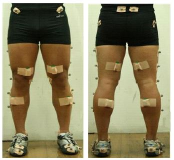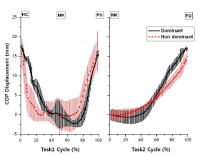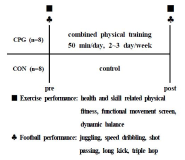
The purpose of this research is to investigate the factors affecting the performance capability of lunge movements by performing lunge movements which are commonly used as a method of instant physical movement in sports with a kinetic analysis including an EMG analysis. This research targeted 14 skilled fencers and made the subjects perform kick-lunges which allow them to go farthest from their positions and performed an analysis on such, applying a 3D motion analysis system and an EMG system. The subjects performed kick-lunges in two movements; one with a preliminary movement and the other without it and those are performed with both dominant leg and non-dominant leg. The result of this research is as follows. The lunges with a preliminary movement showed higher performance capability than those without it. Furthermore, as the level of skills gets higher, the length of lunges gets longer, and it seemed that a tactical mechanism shortening exercise performance times was used as a mechanism to control the impulse coming from such lengthened lunges. In addition, a difference appeared in mechanical factors such as moment and power in a dominant leg movement and it seemed to result from a difference in an functional capability using muscles.





PURPOSE This study investigates the impact of injury experience on ankle dorsiflexion, quadriceps extensibility, and dynamic stability in elite adolescent and adult volleyball players. METHODS A total of 485 players (adolescents=337, adults=115) reported lower extremities injuries, with measurements taken for ankle dorsiflexion and quadriceps extensibility using the weight- bearing lunge test and Ely’s test, respectively. The Y-balance test was used for dynamic stability. Measurements were conducted on the injured leg of players with knee and/or ankle injuries and the dominant leg of healthy players. Four groups were classified based on injury experience, and comparisons were made between both legs. Additionally, the variables of adolescent players were compared to those of adults. RESULTS Adolescent players with knee injuries exhibited a larger difference in ankle dorsiflexion between both legs, while adult players with ankle injuries demonstrated an asymmetry of ankle dorsiflexion. Regardless of age, players with knee or ankle injuries displayed lower dynamic stability compared to healthy players. Notably, adults with knee injuries showed a larger difference in dynamic stability between both legs. CONCLUSIONS To prevent and rehabilitate volleyball-related injuries, comprehensive injury risk factors, including age, should be managed in the injury prevention strategies.

[Purpose] This study aimed to examine the effects of complex physical training on exercise and football performances in youth football players. [Methods] The subjects (n=16) were randomly assigned to either a complex physical training group (CPG, n=8) or a control group (CON, n=8). CPG was performed the complex physical training for 50 minute per day, and 2∼3 times per week, for 8 weeks. Exercise performance (health related physical fitness, skill related physical fitness, Y-balance and functional movement screen; FMS) and football performance (juggling, speed dribbling, shot passing, long kick and triple hop) were measured before and after 8 weeks complex physical training. [Results] Sit-up (p=0.002), sit and reach (p=0.040), 50-m run (p=0.031), side step (p=0.005), single-leg standing with eyes closed (p=0.040), plank (p=0.023), dominant composite score (p=0.002) and non-dominant composite score (p=0.005), deep squat (p=0.009), inline lunge (p=0.042), active straight leg-raise (p=0.015), rotary stability (p=0.049), total score(p=0.001), speed dribbling (p=0.030), dominant triple hop (p=0.001) and non-dominant triple hop (p=0.032) were statistical significant interactions between group and time. [Conclusion] Our findings indicate that complex physical training has beneficial effects on performance improvement of exercise and football in youth football players.

